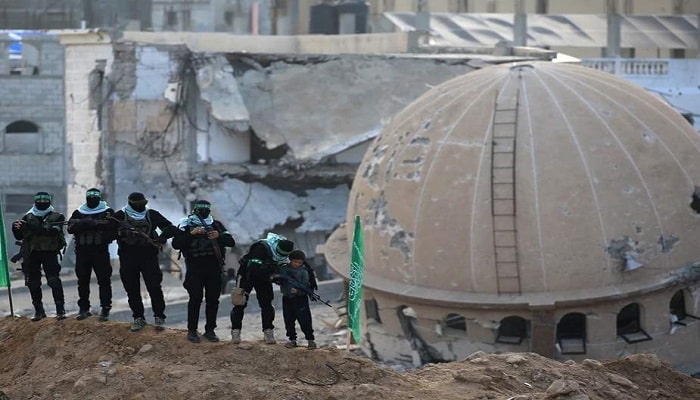PNN – Since armed survival is more important for Hamas at this time than insisting on maintaining the government, its priority is to cooperate with other Palestinian groups, led by Fatah and the Palestinian Authority, to take control of the Palestinians’ management of the reconstruction process in Gaza.
With the start of the ceasefire agreement process in Gaza on Friday, discussions and speculation in the media about how to implement the agreement’s provisions, the Zionist side’s commitment to the ceasefire, and most importantly, the future of resistance weapons and Hamas’s role in Gaza after the war are very heated.
First of all, Hamas’ weapons are a very complex issue, much of which takes place outside the agreement. Certainly, the US and the Zionist regime consider the disarmament of the resistance a key element in realizing their vision for the future of Gaza and the region.
Netanyahu’s interpretation indicates agreement on the need to disband Hamas and, consequently, disarm it, as he stated in his recent statement that if it does not disarm, there is the option of returning to war.
Read more:
Gaza ceasefire violations continue; Tel Aviv halves humanitarian aid
Under such a suspended agreement, Hamas would have no leverage after the hostages are released. This, combined with the vague provisions of the ceasefire agreement, such as the Hamas disarmament clauses (Articles 1 and 13), the future governance of Gaza (Articles 9 and 13), and the redevelopment of Gaza (Articles 2, 10, and 11), gives Israel a lot of maneuvering power and political cover.
For example, the Israeli regime could claim that Hamas is not adhering to the terms of the agreement and then resume bombing, limit aid, or return to the policy of internal and external displacement of Palestinians.
While Article 12 correctly states that “no one shall be forced to leave Gaza,” if there is no deterrent, the regime can make conditions there so unfavorable that they will have no choice but to leave if they want to survive.
Paragraphs 15 and 16 stipulate that the United States (along with Arab and other international partners) will establish an interim international force to stabilize Gaza to act as a guarantor of this agreement. The Israel Defense Forces (IDF) will also withdraw “based on standards, milestones and timeframes associated with demilitarization.”
But the exact specifications of these “standards, milestones, and time frames” remain unclear and will be difficult for the parties to agree on, as the Zionists insist on holding strategic areas in the Philadelphia axis and the buffer zone in northern Gaza.
It is also possible that Netanyahu’s cabinet could use the ambiguity of these terms to its advantage, justifying the resumption of the war by arguing that Hamas has failed to meet certain conditions.
In this regard, one must also pay attention to the conditions within the regime’s cabinet. The regime’s war cabinet has repeatedly said that it will only stop the war when all hostages are returned and Hamas is destroyed. But these demands were clearly not met in the ceasefire agreement. It was observed that in the vote to approve the ceasefire in the Knesset, five far-right ministers voted against the agreement. Among these ministers was Itamar Ben-Governor, the Minister of National Security, who said that the ceasefire was like “an agreement with Adolf Hitler.”
This opposition bloc will undoubtedly make further threats – and could potentially take action – to topple Netanyahu’s government after the first phase is implemented.
In fact, although the ceasefire agreement may pave the way for an end to the war, there is no certainty that the next steps envisaged in Trump’s 20-point plan for Gaza will be achieved.
Once the hostages are released, Hamas will effectively lose its main trump card at the diplomatic table, and if disarmed, the fate of the people of Gaza will once again be hostage to Israel’s military power and domestic and international policies.
Two Hamas officials told Reuters that the group had not received any formal written guarantees backed by specific enforcement mechanisms, relying only on verbal assurances from the United States and mediators – Egypt, Qatar and Turkey.
The Hamas leaders’ insistence on gambling and the lack of credible guarantees regarding Netanyahu’s control over his behavior after the hostages’ release prove that the resistance has been and is acting quite vigilantly and with red lines in mind when it comes to maintaining weapons.
The war is over and Hamas will never be disarmed, Brick said. Hezbollah is also being equipped even though it has suffered a powerful blow.
This scenario has also been repeated and experienced in the failure of US and Zionist regime efforts to abuse Hezbollah’s weapons surrender clause in the February ceasefire agreement to disarm the resistance in Lebanon. While the regime has shown that it is unwilling to fully implement its commitments, and its occasional attacks on Lebanese airspace and failure to leave five points in the south of the country violate the ceasefire agreement, the resistance has also shown that it has not been burdened with disarmament and that there is no power on the ground to implement this American-Zionist plan.

